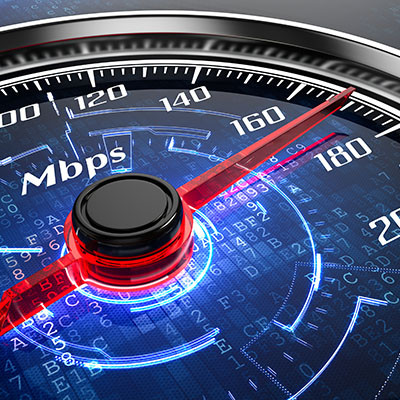Bandwidth Defined
Bandwidth is one of those terms that you think you understand until you try to explain it to someone else. Basically, bandwidth is how fast data can be transferred through a medium. In the case of the Internet, millions of bits need to be transferred from the web to network attached devices every second. The more bandwidth you have access to, the more data can be transferred.
Speed vs Throughput
Network speed--that is, how fast you are able to send and receive data--is typically a combination of available bandwidth and a measure called latency. The higher a network’s latency, the slower the network is going to be, even on high-bandwidth network connections. Latency can come from many parts of the network connection: slow hardware, inefficient data packing, wireless connections, and others.
Throughput is the measure of the amount of data that is transmitted through a connection. Also called payload rate, this is the effective ability for any data to be transmitted through a connection. So, while bandwidth is the presumed amount of data any connection can transfer, throughput is the amount of data that is actually transferred through the connection. The disparity in the two factors can come from several places, but typically the latency of the transmitting sources results in throughput being quite a bit less than the bandwidth.
What Do You Need Bandwidth For?
The best way to describe this is to first consider how much data your business sends and receives. How many devices are transferring data? Is it just text files? Are there graphics and videos? Do you stream media? Do you host your website? Do you use any cloud-based platforms? Do you use video conferencing or any other hosted communications platform? All of these questions (and a few not mentioned) have to be asked so that your business can operate as intended.
First, you need to calculate how many devices will connect to your network at the same time. Next, you need to consider the services that are being used. These can include:
- Data backup
- Cloud services
- Email
- File Sharing
- Messaging
- Online browsing
- Social Media
- Streaming audio
- Streaming video
- Interactive webinars
- Uploads (files, images, video)
- Video conferencing
- Voice over Internet Protocol
- Wi-Fi demands
...and more
After considering all the uses, you then need to take a hard look at what required bandwidth is needed for all of those tasks. Obviously, if you lean on your VoIP system, or you are constantly doing video webinars, you will need to factor those operational decisions into your bandwidth decision making.
Finally, once you’ve pinpointed all the devices and tasks, the bandwidth each task takes, and how many people on your network do those tasks, you total up the traffic estimate. Can you make a realistic estimate with this information? Depending on your business’ size and network traffic, you may not be able to get a workable figure.
Too Much or Not Enough
Paying for too little bandwidth is a major problem, but so is paying for too much. Bandwidth, while more affordable than ever before, is still pretty expensive, and if you pay for too much bandwidth, you are wasting capital that you can never get back.
That’s where the professionals come in. Coleman Technologies has knowledgeable technicians that can assess your bandwidth usage and work with your ISP to get you the right amount for your business’ usage. If you would like more information about bandwidth, its role in your business, or how to get the right amount for your needs, call us today at (604) 513-9428.




